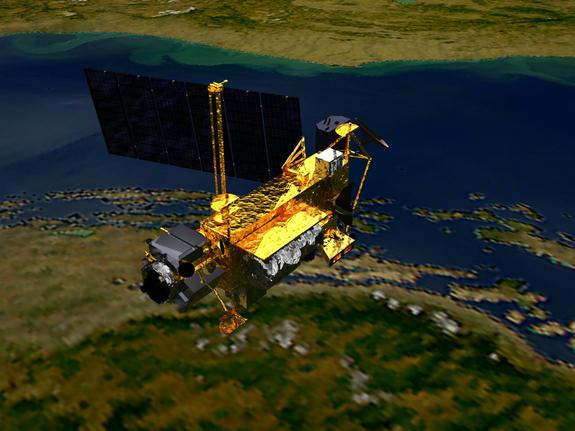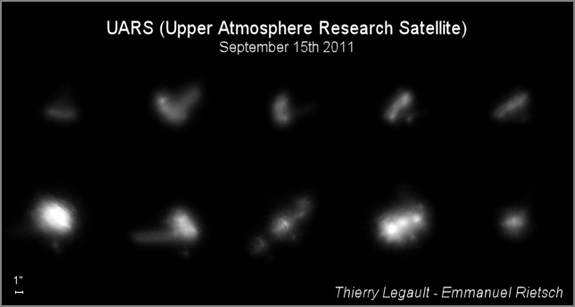Crashing satellite – Update 1209 pm
(NASA)
The NASA UARS satellite is a 6 ton satellite that was placed into orbit by the shuttle Discovery in 1991. Its primary mission was to measure atmospheric chemistry, including ozone. However, as you have probably heard, the satellite has fallen out of its stable orbit. US Air Force Strategic Command (formerly Strategic Air Command) in Omaha, NE now says that the satellite has slowed a little bit, and will likely fall to earth between 7 pm and 11 pm CDT. They do not know exactly where it will fall, and now North America is back in the potential area it could hit. The odds are still very low that anybody will be injured or anything, but several large pieces that do not burn up on re-entry will fall to earth. There are large areas of ocean and uninhabited land it could fall in. But, it is possible that someone, somewhere in the world will get a video of this (especially if it falls in the western hemisphere where it will be night at the time, and a small chance that a piece of the satellite could hit property or even a person. Very small chance.
It is still in orbit right now, with an elliptical orbit that is 100 miles high on the short sides, and 105 miles high on the long sides. The whole thing that keeps a satellite (or a shuttle, etc.) in orbit is its centrifugal force outward into space, since it is going so fast in an ellipse (almost a circle) around the earth. Gravity is pulling it toward earth, but once it is going fast enough, centrifugal force exactly balances gravity and the object is in balanced orbit. The closer the satellite gets to earth, the faster it must go to stay in orbit, because the gravity pulling it gets stronger. This satellite is out of control, going too slow (it needs to be going about 17,000 mph to stay in orbit at that height) and is falling toward earth.
The satellite apparently collided with some other space debris, because it appears to be tumbling downward. Amateur astronomer Thierry Legault captured video of the satellite tumbling over northern France on September 15. Some still images are shown below, or you can see the video at https://www.youtube.com/watch?v=i-vLrBEsPvY. Notice how the satellite’s brightness changes with time as it moves across the sky, showing that it is tumbling.
(Thierry Legault)
However, planet Earth has a defense mechanism built in that protects us from things like this, the atmosphere! As it slowly gets closer to earth, it will encounter an increasingly dense atmosphere that will, through friction and aerodynamics, slow it down (like driving into the wind). The aerodynamic drag pressure on an object is equal to the density of the air times the velocity squared, and with this thing going so fast, even at air pressures of only 0.1 mb (1/10,000th that at the ground), is still large, and just like tires screeching to a halt, it releases about 10 megawatts of energy per square meter (about a square yard) of object falling. A typical electric heater only produces 1000 to 5000 Watts, so this thing will get very hot and mainly burn up on re-entry.
However, a few heavy-metal, large components are expected to make it to the ground, including one as big as 300 pounds. So, you wouldn’t want that coming through your house. But, the odds of it hurting someone, considering all the ocean and forest it could fall in, are very low. As it re-enters, it will produce a fiery light in the sky, but if it is daylight here, even if it passes over us as it goes down, we may not see much.
***WEATHER CLASSES AT JEFF STATE***
Don’t forget to register for one (or both) of the classes I am teaching at Jeff State Shelby Campus this fall. They are not-for-credit, just for fun, so no grades to worry about. To register, go to https://www.jeffstateonline.com/CCCE/Register.aspx.
The times listed on the course schedule have changed.
The Basic Meteorology class, that meets two evenings per week for 4 weeks, will meet every Tue and Thu starting October 11. You can email me at timbhm@msn.com for a syllabus.
The Severe Weather and Tornadoes class will be on October 6.
Category: Hodgepodge

















